Anna Pennemann
Contact
Telephone
(+49)231 755-2352
Address
Department of Biochemical and Chemical Engineering
Laboratory of Solids Process Engineering
Room G3-4.23
Emil-Figge-Str. 68
44227 Dortmund

Contents
Abstract
The uniform coating and encapsulation of particles is essential for many applications, such as coating catalyst particles to prevent abrasion and providing pharmaceutical pellets with gloss, protective or functional coatings. When regarding the pharmaceutical application, coatings can increase API stability, modulate API release and/or enhance patient compliance. Difficulties can occur due to the strict boundaries set by pharmaceutical specifications regarding coating thickness and uniformity as well as the limited excipient options. Following Quality-by-Design concepts, the pharmaceutical industry has gradually begun to adopt continuous manufacturing processes, as these offer manifold benefits. While many processes are inherently suited for continuous manufacturing or easily converted (i.e. extrusion, tableting or roller compaction), continuous coating processes have proven more challenging to implement.
Description
The aim of this work is to develop a novel process for the coating of small particles suitable for fully continuous operation and with the potential to be applied at industrial scale. Pre-existing continuous coating processes share the random particle trajectories of conventional fluidized bed coating, resulting in fluctuations regarding particle residence times and thus coating layer thickness.
As a solution for the previously presented challenges continuous coating processes face, a new process based on the coating of single particles instead of the bulk material was developed. The focus on single pellets enables the elimination of backmixing and ensures identical residence times and process conditions for all particles. The new coating process utilises induced Rayleigh-type jet decay, which is well established for jets exiting capillaries.

Upon completing promising experiments on a laboratory set-up, a patent application was filed for this new process. Current work is focusing on the definition of a design space and the choice of suitable material systems as well as the integration of an efficient infrared drying tunnel. Upon completing the drying tunnel, the resulting layer thicknesses, coating uniformities and coating layer structures will be evaluated and compared to those obtained in conventional coating processes.
Acknoledgements
This project is funded by the German Federal Ministry of Economics and Energy (BMWi) within the framework of the WIPANO programme - "Wissens- und Technologietransfer durch Patente und Normen".
Curriculum Vitae
| Since 2018 | PhD at the Laboratory of Solids Process Engineering, TU Dortmund |
| 2018 | Licensed as Pharmacist |
| 2017 - 2018 | Trainee in Pharmacy "Friedrich-Apotheke", Düsseldorf |
| 2017 | Trainee at NextPharma, Waltrop |
| 2012 - 2017 | Pharmacy Studies, HHU Düsseldorf |
| 2004 - 2012 | Dietrich-Bonhoeffer-Gymnasium, Bergisch Gladbach |
| Born | November 13th, Cologne (Germany) |


